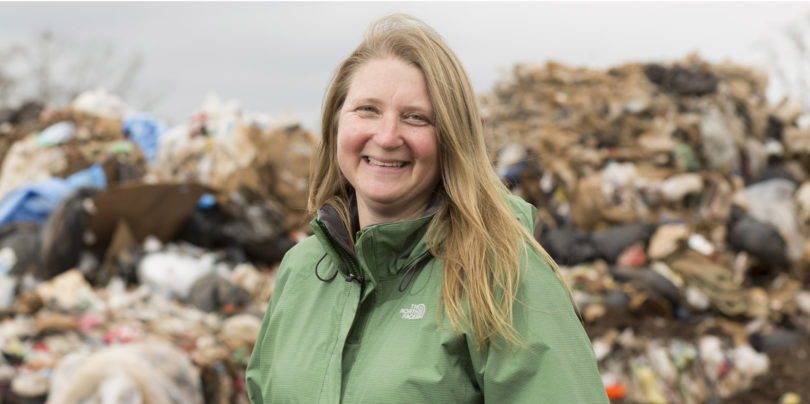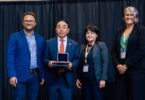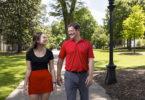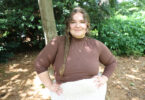Jenna Jambeck, associate professor in the College of Engineering, is internationally recognized for her research on plastic waste in the ocean and for the Marine Debris Tracker app she co-created. She notes that being active in research helps bring current environmental engineering issues into the classroom for students.
Where did you earn degrees and what are your current responsibilities at UGA?
I am an associate professor of environmental engineering in the College of Engineering. I teach classes and conduct research. I got all three of my degrees at the University of Florida, but worked for an engineering firm, URS Corp., in Minnesota between my master’s and Ph.D.
When did you come to UGA and what brought you here?
I came to UGA in the summer of 2009 from the University of New Hampshire, where I was a research professor. I was excited about the opportunity to help build not only a new environmental engineering program, but also a new engineering college at UGA. Also, the strong arts and sciences at UGA, as well as the mission for engineering to work across all disciplines, was a big draw for me; I think that we need interdisciplinary efforts and collaborations to help address the sustainability challenges currently facing us.
What are your favorite courses and why?
I teach a core environmental engineering course called “Urban Systems.” In this course, I introduce concepts of green engineering, systems thinking for urban systems, and also cover drinking water treatment, wastewater treatment and integrated solid waste design, plus a lab. It is a packed course, but I teach it with project-based learning. Students take ownership of their own community, designing the environmental engineering infrastructure after a natural disaster to illustrate important concepts of resilience and unintended consequences.
What interests you about your field?
I fell in love with the study of solid waste management when I had to pick a focus in environmental engineering as an undergraduate student. What really interested me was the strong connection between integrated waste management design and people—of my choices, it seemed to me to involve people more than the others, and this added to the richness of the focus for me. Our waste management practices are embedded in our social and cultural structures and are different throughout the world. I enjoy visiting waste management facilities in other countries and I photograph trash cans around the world. When I heard about marine debris as an issue in the late 1990s, I knew instantly that I wanted to study how our waste management (or lack thereof) could impact how much trash ends up in our oceans.
What are some highlights of your career at UGA?
For my NOAA grant, the Southeast Atlantic Marine Debris Initiative (SEA-MDI), we created the mobile app Marine Debris Tracker (along with Kyle Johnsen in Engineering). A highlight was when Marine Debris Tracker was mentioned in an Apple promotional video at the 2014 Worldwide Developer Forum. Because of my marine debris work, I was asked to be on an international scientific working group and got to sail across the Atlantic on eXXpedition, an all women-crewed voyage studying plastic and toxics in the ocean. It also was a highlight to be recognized in 2013 by the National Academy of Engineering for my teaching of my urban systems course in an award to attend the Frontiers of Engineering Education workshop. And I feel very honored when students who have started their jobs email me to tell me my classes really helped them get their position and do their work.
And just recently I was at the Global Ocean Commission meeting, where I spoke in the morning to about a hundred top industry and government officials. The undersecretary of state quoted my research in the morning to kick off the meeting. Then, in the afternoon, both David Miliband (president and CEO of the International Rescue Committee and a former U.K. foreign secretary) and His Royal Highness the Prince of Wales (Prince Charles) gave speeches as well, and both quoted my work.
How does your research or scholarship inspire your teaching, and vice versa?
Urban systems are a growing part of our world where my teaching and research intersect. The concepts of resiliency and unintended consequences are also both illustrated in my teaching and research. Being active in research means I can bring current environmental engineering issues into my classes—from the projects I offer to the students in sophomore design, to the issues we discuss in urban systems, to the current events we study in energy and environmental policy. It keeps the classroom experience dynamic, which benefits everyone.
What do you hope students gain from their classroom experience with you?
Resilience and confidence to be able to figure things out. I teach my design classes in such a way that students are allowed to make mistakes and learn from them, before they get a final grade. Engineering can be a very high pressure major where mistakes can be costly, yet failure is often a part of the design process. We do calculation checks and I comment on reports so that students can revise and correct so that they learn through the process of design and communication. Knowing how something doesn’t work is often as important as knowing how something does work.
Describe your ideal student.
So they get practice, I have students do activities in class that are typical for engineers to do in the “real world”—write design calculations, write reports, present to the class as a community, work in groups and discuss current events. My ideal student is one who really takes the opportunity to practice being an engineer; they are interested in learning from and engaged in the experience, the design process and the activities we do in class.
Favorite place to be/thing to do on campus is…
When it is nice outside in the fall and I have a discussion class planned for my “Energy and Environmental Policy Analysis” course, I can take my class outside into the Driftmier courtyard to teach.
Beyond the UGA campus, I like to…
Outside of campus, I spend my time with my husband and two young sons, mostly playing or working outside on our property. I also enjoy going to the beach, swimming and taking photos, which often include trash cans and waste management practices when I travel. I have to admit I also enjoy logging litter or marine debris with Marine Debris Tracker.
Community/civic involvement includes….
I have worked with or presented at the Child Development Lab at the McPhaul Center, Barrow Elementary, Athens Montessori, Double Helix STEAM Academy and Girl POWERed, a local running program for girls in grades four through eight. I have had a table at Barrow Elementary School’s Green Fest since it began, and I have done several panels for the EcoFocus Film Fest in Athens and Jekyll Island Green Screen events.
Favorite book/movie (and why)?
My favorite book is “A Wrinkle in Time” by Madeleine L’Engle. This book inspired me to closely intertwine being a researcher and a mom.
Proudest moment at UGA?
Publishing the paper, “Plastic waste inputs from land into the ocean,” in Science and presenting it at a press briefing panel at the AAAS meeting in February 2015.








